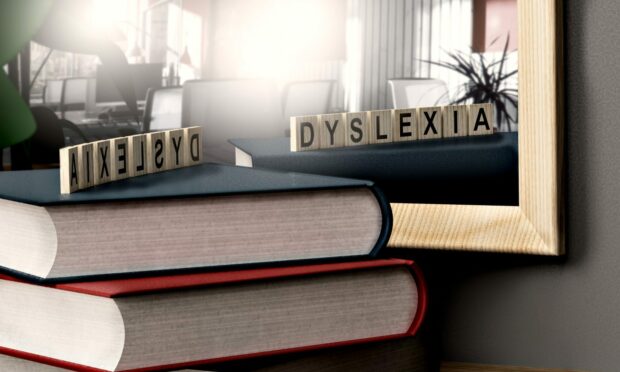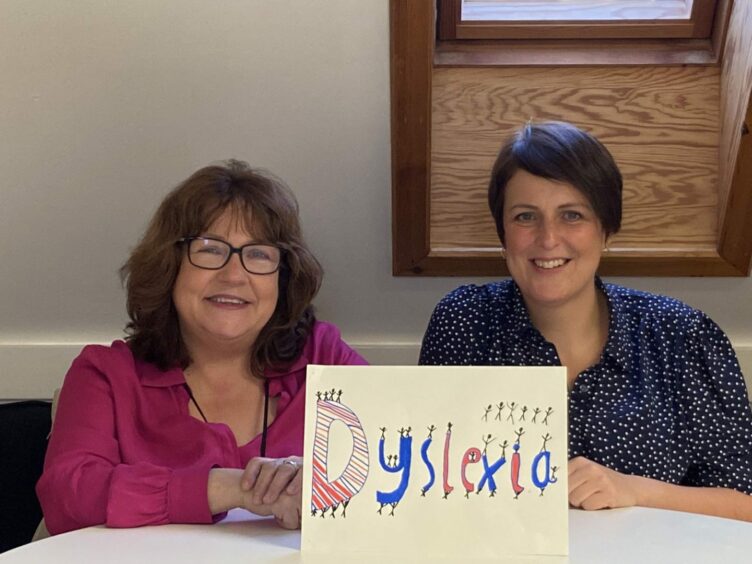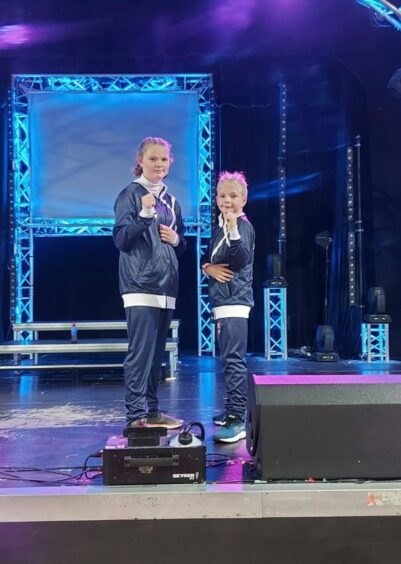When you think about dyslexia, you probably think about reading and writing.
But there’s far more to it than that. While classed as a disability under the Equality Act, people with dyslexia say that in itself can create confusion.
Despite being a disability, dyslexia has nothing to do with intelligence.
It’s a learning difference and that’s just how it is for everyone who has it: different.
Your image of dyslexia might look something like this simulation created by Victor Widell:

But Vicki Ward, who runs Highlands Dyslexia, said that the reality for many people with dyslexia will be nothing like jumbled or roving letters.
“Dyslexia can look really different in different people. There are never two profiles that are exactly the same.
“Some people have different strengths and different areas of struggle, and some people mask things better than others.”
Highlands Dyslexia provides screening and tuition for young people and adults.
We spoke to a family with dyslexia in Elgin who worked with Vicki to build strategies and identify their dyslexia.
And in the Western Isles, a new advocacy group is fighting for a bill to make it easier to identify dyslexia and train teachers how to help dyslexic students in the classroom.
Brain like a bookshelf
For Emily Sayle and her children, their dyslexia makes it hard to stay organised.
Emily said her memory can feel like a bookshelf without enough space: Everything she adds to the shelf is likely to push something else off the other end.
“People always say: ‘Oh, we all do that.’ Yeah, but I do it all the time,” she said. “All the time.
“And it’s that bit that makes it hard. When you say dyslexic, people tend to think it’s just reading and writing, but that’s not it. It’s so much more. So much more.”

For Emily, her biggest struggle as a child and now as an adult was staying organised.
“My children are different again to me,” she said. “Noah struggles mostly with visual tracking. His words will move or morph when he’s trying to read them.
“In Primary 3, he was struggling to read, thinking he was stupid. The poor kid thought it was normal.”
Reading, recognising or decoding?
Emily said that Noah and Natalie both see letters as shapes.
“He won’t see it as the word ‘at’, he’ll see it as a shape. So he’s got to remember that that shape is the word ‘at’.
“He struggles to decode words. And he can and will read now, but he’s not an avid reader. We all use audiobooks.”
Noah and Natalie both have a bank of words that they know on sight, without decoding the individual letters or syllables. They will know to put shapes together by memory as opposed to reading them as a word.
“They’re not given enough credit for the effort they’re putting in to keep up with their peers, particularly if they’re not being supported.”
-Emily Sayle
For Noah, 10, instructions are important. He’s a very visual learner, and does a lot of his work by memorisation.
Older sister Natalie, 15, is in secondary school. She’s developed her own ways of making life with dyslexia work, from reminders and sticky note apps on her phone to colour-coded notebooks and timetables.
Sometimes it can be too much
She does well in school and is able to keep pace with her classmates, but she finds that she’s often more exhausted at the end of the week than they are. Some days, she’s too exhausted from school to get every assignment done.
And she said it can be difficult to communicate her situation to teachers.
“If it’s a teacher who understands, I think it’s easy to go and speak to them and explain what’s happened. But when the teacher doesn’t understand why you struggle, it’s hard to go speak to them.
“I like people to understand, and so I try to explain sometimes. But other times I think it’s just too much effort to explain to someone else and go through that again.”
Dyslexic students deserve more credit
Emily understands completely. She didn’t bristle when Natalie mentioned an English essay that simply never got done. She wants dyslexic children to get a lot more recognition for their work.
“Dyslexic kids in general, but any child with a learning difference, aren’t given enough credit for how much they have to try.
“Even just trying to do the homework, it is a lot to them. In a normal six-hour day, dyslexic children put in the energy of a 10-hour day and then have to go on to do the homework.
“They’re not given enough credit for the effort they’re putting in to keep up with their peers, particularly if they’re not being supported.”
But adequate support begins with adequate awareness. Enter: A Dyslexic Life, run by Donna Macleod and Cathy Anne Dunn.
Dyslexia isn’t a barrier
From their base in the Western Isles, they are campaigning to bring a dyslexia screening and teacher training bill to Scotland. A bill already exists in England, but it doesn’t cover Scottish education or Scottish children.
And there are a lot of children who can use that coverage, Ms Macleod said.
According to statistics from the Scottish Government, there are thousands of students across the north and north-east with dyslexia.
Ms Macleod and Ms Dunn said that there are still too many students whose dyslexia is never identified, and it leads to struggles throughout their school careers.
That means setbacks that aren’t necessary, awkward conversations with teachers that don’t need to happen, and missed opportunities that could have been possible with better symptom management.
And what can someone with dyslexia do if they’re able to tackle their symptoms head-on? This autumn, Natalie and Noah travelled to Wales for the World Kickboxing Association world championships.
Noah won gold in points fighting in the 10-11 years, 35-40kg class and is now WKA World champion. He also achieved silver in the 10-11 years, 40-45 kg class.
Natalie, despite being only 15, competed in the 18-34 years, 65-70 kg class. She came away with a bronze and silver medal of her own.
Read more from the Schools and Family team
Aberdeenshire experts share their advice for supporting children with dyslexia



Conversation